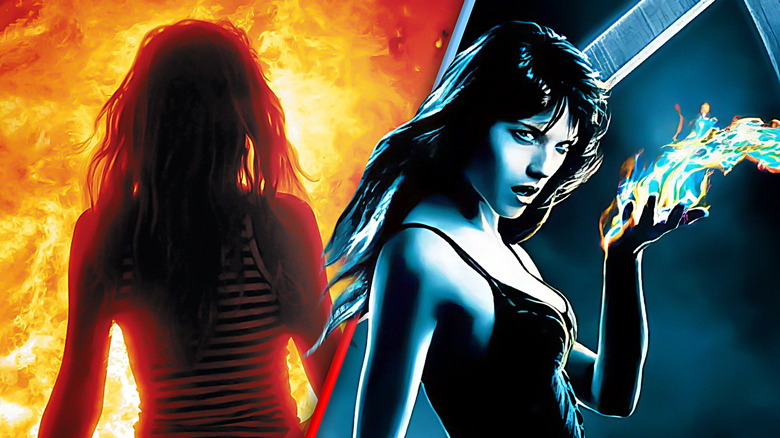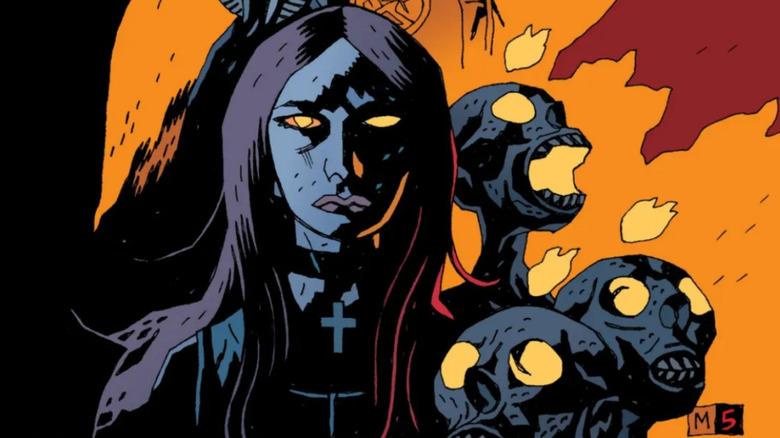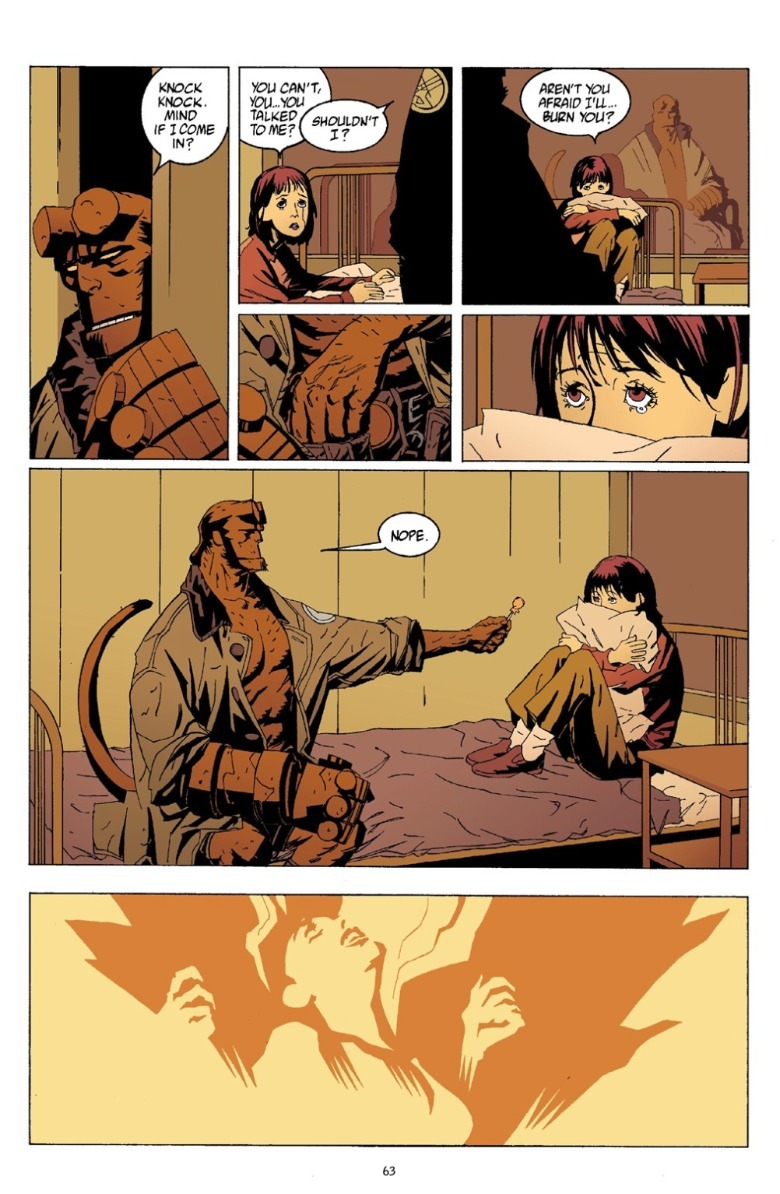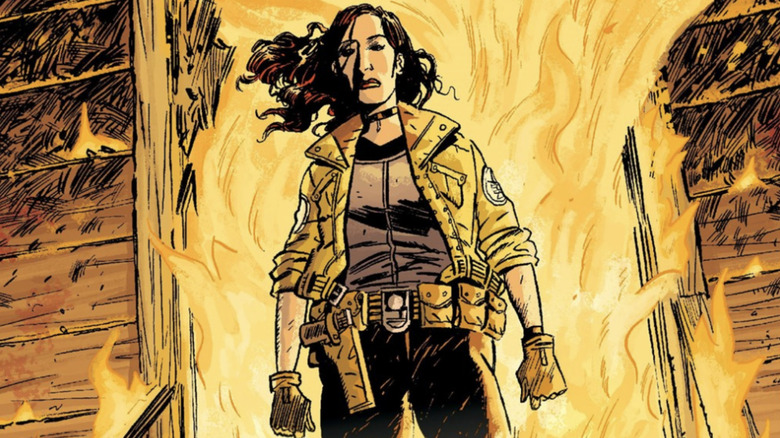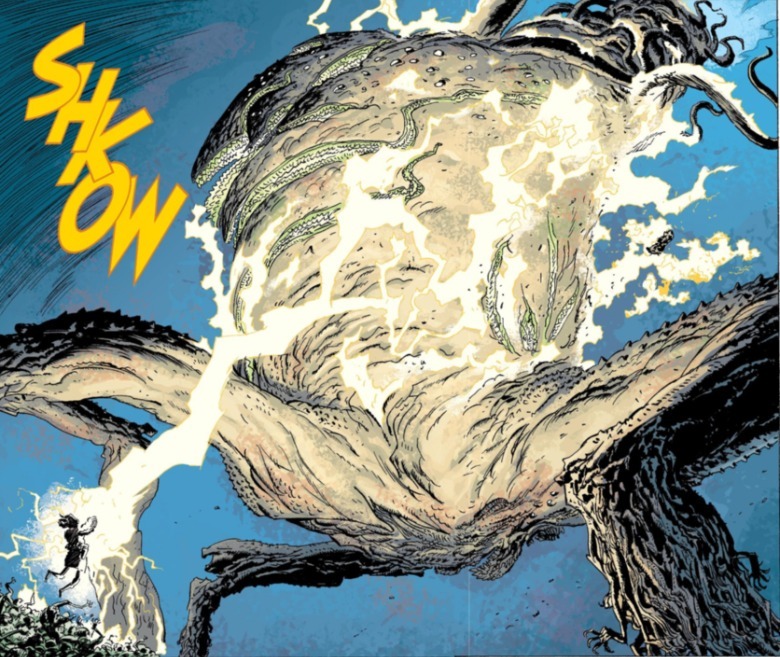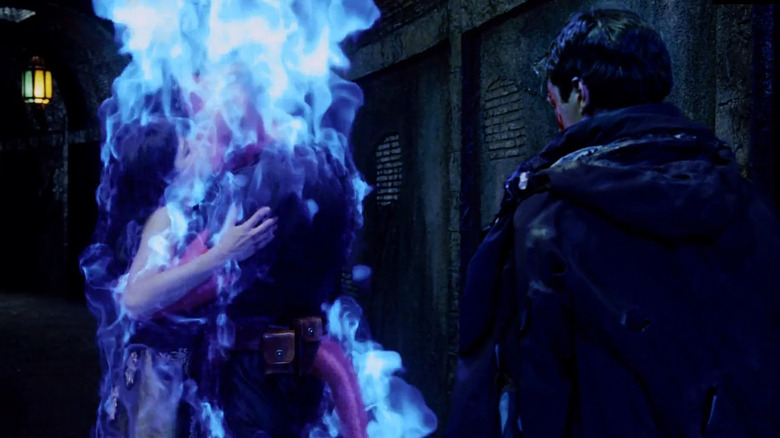This Hellboy Heroine Is A Homage To A Classic Stephen King Story
Stephen King is primarily a prose writer, but he loves comic books too. He's dipped his toes into the graphic medium, contributing to 1985 one-shot "Heroes for Hope: Starring the X-Men" (a "comic jam" featuring writing from Alan Moore and George R. R. Martin too), and co-writing the horror comic "American Vampire" with Scott Snyder.
Before those, King's eighth novel — "Firestarter" — was him telling a superhero story in the horror space. "Firestarter" follows the McGees, a father (Andy) and daughter (Charlie) on the run from a government agency called the Shop. Years prior, Andy and his wife Vicky volunteered for experiments with the drug Lot 6, which turned him into a psychic and made Charlie born a "firestarter," able to spark flames with a thought.
King's seventh novel, "The Dead Zone," was about a man gaining clairvoyance and ultimately trying to assassinate a political candidate he foresees causing a nuclear war. "Firestarter" feels like a spiritual sequel, sharing psychic protagonists and a post-Watergate cynicism of government. (In a "Firestarter" afterword, King cites the CIA's real MKUltra drug experiments as an influence.)
Like most King books, "Firestarter" has been adapted to film — first in 1984 (starring a young Drew Barrymore as Charlie), and then in 2022. Neither film version is too beloved (/Film's review of the 2022 "Firestarter" called it "lukewarm at best") and King himself disliked the '80s one. Watching it, one wonders if the premise was innately better suited for a book. Fire is such a visual horror, but you can only make a close-up stare of a little girl so scary once, let alone repeatedly.
Despite its rocky onscreen record, "Firestarter" dug its roots into pop culture. Wolverine's backstory, a superhuman a clandestine government group tried to make into a weapon, feels much like Charlie's. So does Eleven's (Millie Bobby Brown) in "Stranger Things." Elizabeth "Liz" Sherman, a pyrokinetic monster hunter in Mike Mignola's "Hellboy" comics, also feels like a grown-up Charlie McGee.
Hellboy's Liz Sherman is a hero right out of Firestarter
Liz Sherman is one of the original three heroes of the "Mignolaverse," introduced alongside Hellboy himself and the fishman Abe Sapien in the 1994 comic "Seed of Destruction." The only one of the trio who can pass as a normal human, Liz has hair as red as her flames and an on-off smoking habit (since she doesn't even need a match to light up). She often wears a cross necklace too, a sign of her enduring Catholic faith even as she meets supernatural beings never mentioned in the Bible. Mignola has not to my knowledge cited King's book as an inspiration for Liz, but she's literally called a "fire starter" in the comics.
Liz's backstory, established from the beginning, has her born in Kansas City with inexplicable and near-uncontrollable pyrokinesis. At age 11, while feeling angry from a neighbor's name-calling, she accidentally started a fire that killed 32 people, including her parents and her brother. Like Charlie, Liz was taken in by a government agency (thankfully, the Bureau of Paranormal Research and Defense (B.P.R.D.) is more benevolent than the Shop). Hellboy, used to feeling like an outsider, was the first to approach Liz without fear in his eyes, beginning their friendship.
Liz becomes a damsel in distress during "Seed of Destruction" thanks to the villain Grigori Rasputin (not the only time the "Mad Monk" has been reimagined as an immortal super-villain, from Don Bluth's Disney-ish animated epic "Anastiasia" to "The King's Man"). The sorceror steals and channels her powers to summon his masters the Ogdru Jahad, the seven-headed beast of the apocalypse.
In the second "Hellboy" miniseries, "Wake The Devil," the team is again fighting Rasputin, this time in Romania. While investigating an abandoned castle, Liz and other B.P.R.D. agents come across an inert homunculus that needs a spark to come alive. Liz offers it her own pyrokinesis abilities when her self-loathing takes over. She understandably sees her powers as a curse, one given by God to punish her for some unknown sin — the fire did kill her family — so any chance to be rid of them, no matter how reckless, she takes. It works and the homunculus comes to life, but in the follow-up story "Almost Colossus," it turns out that without the fire, Liz's own soul will be snuffed out. To save her, Hellboy has to find the homunculus (named Roger).
Mignola had plans to kill Liz in "Almost Colossus," writing he "never had any real idea of what to do with her, so I thought I'd get rid of her. Lazy me." A talk with animator Glen Murakami convinced Mignola to spare her (in "Almost Colossus," Liz briefly dies but when Roger returns the fire, it restarts her heart). Liz has remained one of the "Hellboy" series' main heroes since.
Liz Sherman is a star of the B.P.R.D. comic books
Hellboy leaves the B.P.R.D. at the end of 2001 mini-series "Conqueror Worm," so Liz and his other former colleagues stop showing up in his stories. She's nowhere to be seen, for instance, in the climactic Blood Queen trilogy ("Darkness Calls," "The Wild Hunt," and "The Storm and the Fury") where Hellboy has to finally save or doom the world.
That's not to say Liz vanished from comics. 2011 mini-series "The Dead Remembered" (written by Mignola and Scott Allie, drawn by Karl Moline) follows 14-year-old Liz's first B.P.R.D. mission: investigating ghost sightings in Salem, Massachusetts alongside her new guardian, Professor Trevor Bruttenholm. Making Liz the hero of a ghost story drawing on the Salem Witch Trials, where women were burned alive? It's so obvious it's brilliant.
Liz is also one of the leads in "B.P.R.D." spin-off comic (primarily written by Mignola and John Arcudi and drawn by Guy Davis). The series follows the Bureau after Hellboy's departure; even without him around, there's still an apocalypse to prevent. Roger the homunculus is also part of the main cast, and he shares a special bond with Liz since she gave him life.
Past "Hellboy" comics had already established that Liz's powers were unpredictable, and "B.P.R.D." focuses on her struggle to control them. Whenever she needs to summon flames, she tells herself again and again: "The fire is not my enemy, it is a part of me, it is mine." By saying those words enough to believe them, she pulls off feats like torching a frog kaiju laying waste to Nebraska.
"B.P.R.D." delves into the root of Liz's powers. Rasputin claimed all the way back in "Seed of Destruction" that "[Liz's] power is a living thing," and it's true. Memnan Saa, an evil sorcerer obsessed with Liz, reveals her fire comes from Vril, the flame of life that arrived on Earth when angels (or Watchers) stole it from God. (In "Hellboy," all myths have truth to them, including the story of Prometheus.) That the name "Vril" evokes "Virile," or strong and full of life, is probably no accident. This is another difference between Liz and Stephen King's firestarter; Charlie's powers were science-fiction, hers are magic.
Guillermo del Toro made Hellboy and Liz lovers
Selma Blair plays Liz Sherman in the two "Hellboy" films directed by Guillermo del Toro, opposite Ron Perlman as Big Red himself. In the first film, she's initially left the B.P.R.D. to seek help in an institution. Her pale skin, withdrawn personality, and black (not red) hair make the movie Liz look more Goth-ish than the comics. While her flames are mostly colored orange in the comics, they're blue in the films (Azula called). After all, despite her powers, she's not a fiery person, she's a melancholic one.
The big change to Liz in the del Toro "Hellboy" films though is that she and Hellboy aren't just friends — they're lovers. Hellboy spends the first movie pining after Liz, unable to fully express his feelings, like a lovesick and jealous teenager. The climax of the movie (loosely adapting "Seed of Destruction") reframes Rasputin holding Liz hostage as him forcing Hellboy to choose the world or his beloved. The film ends with Hellboy and Liz kissing, both engulfed in blue flames that harm neither of them, for their passion is pure. Sequel "Hellboy II: The Golden Army" in turn ends with Liz revealing she's expecting Hellboy's twins, setting up a third film that sadly never came to be.
This was years before comic Hellboy fell in love — not with Liz, but with Irish maid Alice Monaghan, whom he once saved from Fae kidnappers in classic Hellboy story "The Corpse." Mignola's Hellboy is a more stoic character than the movie version, based on the creator's own father (a cabinet maker who had a stiff upper lip). Del Toro has said that Mignola's mix of "blue collar" and high fantasy is what attracted him to "Hellboy," but he also put his own stamp on the character. Unlike Mignola, del Toro is a romantic, so he puts his monsters into love stories (see: "The Shape of Water").
Hellboy & Liz's love is a change that works well for the movies, but I'm also not complaining that Mignola never lit this spark in the comics.
